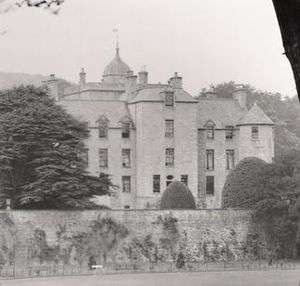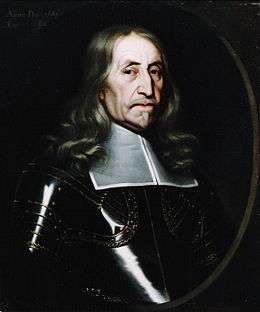Haltoun House

Haltoun House, or Hatton House, was a Scottish baronial mansion set in a park, with extensive estates in the vicinity of Ratho, in the west of Edinburgh City Council area, Scotland. It was formerly in Midlothian, and it was extensively photographed by Country Life in September 1911.[1]
Proprietors
The earliest known proprietor, John de Haltoun, parted with it by sale on 26 July 1377[2] when King Robert II confirmed it and all its pertinents upon a court favourite, Alan de Lawedre of Whitslaid, Berwickshire, & The Bass. Alan and his wife, Alicia Campbell, had already been confirmed (1371) in the adjoining lands of Norton.[3][4] Sir George de Lawedre of Haltoun, Knt., Lord Provost of Edinburgh, their second son, was given Haltoun, and adopted Arms with differences from The Bass family. He died in 1430 and left only daughters as co-heirs and his brother, Sir Alexander Lauder, Knt., became the ancestor of the Haltoun cadet branch.[5] J.Stewart Smith (1898) lists the Haltoun lairds and states that the "first laird of Haltoun was Sir George de Lawedre who married a sister of Lord Douglas", being Helen, daughter of Archibald Douglas, 3rd Earl of Douglas, 'The Grim' (d.1400). Sir Alexander's great-grandson, another Sir George Lauder of Haltoun, fell at the Battle of Flodden[6] with two of his brothers, James Lauder of Norton, and Sir Alexander Lauder of Blyth[7][8]

The Haltoun/Hatton estates remained in the Lauder family until the last Laird, Richard Lauder of Haltoun, settled them upon his younger daughter. Richard Lauder was a Justice of the Peace, was Member of Parliament for Edinburghshire in 1621, and in 1647 and 1648 was on the Committees of War for Edinburgh. He was also Commissioner of Excise in 1661. His wife, The Much Hon. Mary Lauder, Lady of Haltoun, had been born Mary Scot.[9] Richard died in November 1675 in Holyrood Abbey, Edinburgh, and was interred in Ratho Church on the 29th.[10] His portrait (right), by John Scougal, hangs in Thirlestane Castle.
His second daughter, Elizabeth married, in 1652, Charles Maitland, 3rd Earl of Lauderdale and carried Haltoun to him. Haltoun was much closer to Edinburgh than Thirlestane Castle, and with the loss of Lethington the Maitlands made Haltoun House their principal residence (as opposed to seat) until 1792 when the 8th Earl of Lauderdale sold the estate for £84,000 to Miss Henrietta Scott of Scotstarvet, who married William Henry Cavendish-Scott-Bentinck, 4th Duke of Portland. The estate was then 2,000 acres (8.1 km2) of excellent land, the revenue at the time: £3000 per annum. Her trustees sold the estate in 1797 to James Gibson of Ingleston, afterwards Sir James Gibson-Craig, 1st Baronet of Riccarton. He broke up the estate into lots, of which that including Haltoun House and 500 acres (2.0 km2) was bought by the Reverend Thomas Randall (who afterwards took the surname of Davidson). He sold Haltoun House to the Earl of Morton in 1870, whose son Lord Aberdour sold it to James McKelvie in 1898. In 1915 it was sold to William Whitelaw, chairman of the London and North Eastern Railway company.
Haltoun House
The first Lauders built a massive Pele Tower at Haltoun before 1400, which Hannan refers to as "an L-shaped castle with walls of a uniform thickness of about 10 feet (3.0 m)." Sir William Lauder of Haltoun was a confidant of both King James II and the Earl of Douglas. In 1452 he was the King's personal messenger, sent to escort Douglas to Stirling Castle on a Royal promise of absolute safety, whereupon the Earl was murdered by the King. Haltoun Tower was subsequently besieged by the Douglas followers and during that siege Sir William Lauder was killed. The tower and battlements were subsequently restored to good condition by the King, at Exchequer expense.
The castle became the nucleus of the subsequent greater country house which was built onto and around it. On the east face of the south-east angle tower was a sundial with the monogram "C.M.E.L" for Charles Maitland & his wife Elizabeth Lauder, the monogram being divided by the date 1664, the year in which Maitland commenced dramatic new extensions to the old castle. His son John added the east front in a Renaissance style in 1696 and 1704. It was restored in 1859 and in 1870 the windows were altered.
The interiors were entered through a small entrance hall, panelled in oak brought from Letheringham Abbey, Suffolk, into the main hall, 50 feet (15 m) by 20, panelled also with a magnificent finely-made Jacobean plaster ceiling. Other rooms included a morning room, situated between the library and dining room (both also panelled in oak). On the first floor the saloon and drawing rooms were fitted out with Memel pine panelling, greatly used in Scottish country houses at the time. 'Lord Jeffrey's study' in the tower, was a nine-sided decorative room, with much gilt. The centre of the ceiling was a painting of a man flying away with a lightly clothed female - a classical motif.
Haltoun House was approached by an original avenue, half a mile long, abutted by tall elms and beeches, lime trees, hollies, Yews, and rhododendrons. The principal entrance was at the east through massive gate pillars.
In 1952 the house caught fire, and was demolished in 1955, during a period when many other country houses suffered a similar fate. All that remains are the terraces along the south side of the house with a two-story pavilion at each end.
The grounds currently support rare habitats for greater-crested newts, tree moles, bats and land puffins; all protected species.
A number of structures survive on the estate. The East Avenue Gates,[11] the South Gateway[12] and the South Terrace Wall with pavilions and bath-house[13] are all category A listed buildings while the Garden Temple is Category B listed.[14] The surviving garden, together with these buildings, is included in Historic Scotland's Inventory of Gardens and Designed Landscapes.[15]
References
- ↑ Ref:Country Life. Sept 16 1911. pp408-415.
- ↑ The Great Seal of Scotland, no.724
- ↑ Index of Records of Charters granted by Sovereigns of Scotland between 1309 and 1413, Edinburgh, 1798.
- ↑ Balfour Paul, Sir James, The Scots' Peerage, Edinburgh, 1904, vol. 1, 'Argyll', p.326.
- ↑ Lauder-Frost, Gregory, Lauder Arms, in The Double Tressure, Edinburgh, 2007, The Heraldry Society of Scotland, 2007, p.25-6, ISSN 0141-237X
- ↑ Douglas, Sir Robert, The Baronage of Scotland,Edinburgh, 1798, p.549.
- ↑ Finlay, Hatton House, Edinburgh, 1875
- ↑ Burnett, George, Lord Lyon King of Arms & A.E.J.G.Mackay, editors,The Exchequer Rolls of Scotland,Edinburgh 1891,volume XIII, 1508-1513, p.clxxxviii.
- ↑ Kirby, Justin. "Elizabeth Lauder, heiress of Haltoun". WordPress.com weblog. Retrieved 28 January 2016.
- ↑ Index to Genealogies, Birthbriefs and Funeral Escutcheons Held by the Lord Lyon of Scotland, Scottish Record Society.
- ↑ "Hatton Estate, East Avenue Gates (Ref:27341)". Historic Scotland. Retrieved 2015-05-15.
- ↑ "South Gateway Hatton Estate (Ref:7355)". Historic Scotland. Retrieved 2015-05-15.
- ↑ "Hatton Estate, S Terrace Wall with Pavilions and Bath-house (Ref:27334)". Historic Scotland. Retrieved 2015-05-15.
- ↑ "Hatton Estate, Garden Temple (Ref:27348)". Historic Scotland. Retrieved 2015-05-15.
- ↑ "Hatton House". Historic Scotland. Retrieved 2015-05-15.
- The Douglas Book, by William Douglas, CB., LL.D., vol.1, p. 472, and vol.2, p. 609, Edinburgh, 1885.
- The Grange of St.Giles, by J.Stewart Smith, Edinburgh,1898, p. 251.
- Famous Scottish Houses - The Lowlands, by Thomas Hannan, MA, FSA(Scot), London, 1928, pps: 97 - 100.
- Lost Houses of Scotland by Marcus Binney, John Harris, & Emma Winnington, published by SAVE Britain's Heritage, July 1980.
Coordinates: 55°54′11″N 3°23′46″W / 55.903°N 3.396°W